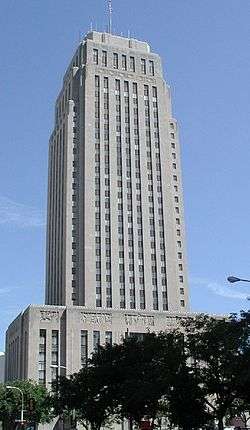Kansas City City Hall
| Kansas City City Hall | |
|---|---|
 | |
| General information | |
| Status | Complete |
| Type | City hall |
| Location | 414 East 12th Street, Kansas City, Missouri |
| Country | United States |
| Coordinates | 39°06′02″N 94°34′41″W / 39.100569°N 94.577997°WCoordinates: 39°06′02″N 94°34′41″W / 39.100569°N 94.577997°W |
| Construction started | 1935 |
| Completed | 1937 |
| Owner | City of Kansas City |
| Height | |
| Roof | 151.1 m (496 ft)[1] |
| Technical details | |
| Floor count | 30 |
| Design and construction | |
| Architect | Wight and Wight |
The City Hall of Kansas City, Missouri is the official seat of government for the city of Kansas City, Missouri. It is a 29-story skyscraper located in downtown Kansas City, and has an observation deck on the top of it. It is the fourth-tallest city hall in the world, and the seventh-tallest building in Kansas City.
The building was built in 1937, under the influence of Tom Pendergast (who owned a concrete company that built the city hall), the "political boss" of Kansas City at the time. It was built to "counter" the effects of the great depression on Kansas City, and was part of a series of other government buildings, which include the Jackson County Courthouse. Both buildings were designed by Wight and Wight.
The mayor's office is on the 29th floor and the City Council chamber is on the 26th floor. The city hall is considered a "Beaux-Arts" style building, but has Art Deco elements on the interior. The interior of the city hall is full of Italian gray, red, white, and green marble which lines the halls and the floors of the building. It was dedicated on October 25, 1937, and required 20,000 cubic feet (570 m3) of concrete, 7,800 tons of stone, 6,800 tons of steel and, as one newspaper put it, "a lake of paint" to build. One Kansas City Place, the tallest building in Kansas City and the state of Missouri was built based as a tribute to the architectural style of City Hall.
Sculptures on the exterior of the building include those by C. Paul Jennewein, Ulric Ellerhusen and Walker Hancock.[2]